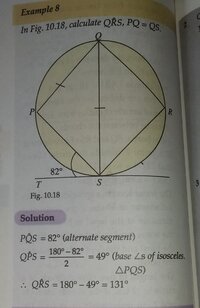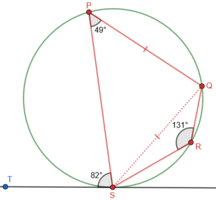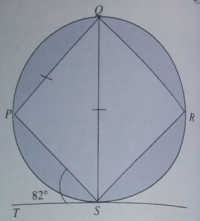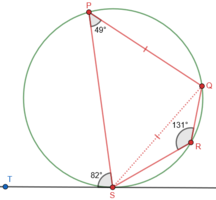You are using an out of date browser. It may not display this or other websites correctly.
You should upgrade or use an alternative browser.
You should upgrade or use an alternative browser.
Calculate QRS. (Why is angle QRS = 131 degrees?)
- Thread starter chijioke
- Start date
Dr.Peterson
Elite Member
- Joined
- Nov 12, 2017
- Messages
- 16,604
The last step, QRS = 180 49, is because the arcs intercepted by QPS and QRS add up to 360 degrees, so the angles add up to 180.View attachment 34937
Why is angle QRS = 131 degrees? Is that the triangle SPQ equals triangle SQR so that the two triangle become isosceles triangle?
The isosceles triangle is the reason for the previous step, as stated. Do you understand that part?
The Highlander
Senior Member
- Joined
- Feb 18, 2022
- Messages
- 1,059
Would PQRS not have to be a circle for that to be true? ?The last step, QRS = 180 49, is because the arcs intercepted by QPS and QRS add up to 360 degrees, so the angles add up to 180.
I don't understand any of this! ???The isosceles triangle is the reason for the previous step, as stated. Do you understand that part?
If PQRS is a circle then PQ cannot equal PS (unless they are coincident diameters and then there is no Δ PQS!) and ∠QRS appears to be standing on the diameter PS so must surely be 90°!???
What kind of Maths textbook is this? ?
Dr.Peterson
Elite Member
- Joined
- Nov 12, 2017
- Messages
- 16,604
It would indeed be a good idea if the problem had clearly said that PQRS is a circle (and TS is tangent to it), and also that the figure is utterly not-to-scale; specifically that QS is not a diameter. It's problematic that they make you guess from the figure that it is meant to be a circle, but not that QS is a diameter as it appears to be. The only thing that saves the problem for me is that the segments that are said to be congruent can't be what they appear to be, so I'm forced to redraw the figure.Would PQRS not have to be a circle for that to be true? ?
I don't understand any of this! ???
If PQRS is a circle then PQ cannot equal PS (unless they are coincident diameters and then there is no Δ PQS!) and ∠QRS appears to be standing on the diameter PS so must surely be 90°!???
What kind of Maths textbook is this? ?
(You meant QS, not PS, right?)
The Highlander
Senior Member
- Joined
- Feb 18, 2022
- Messages
- 1,059
Yes, indeed, the question states: PQ=QS and that is what I meant to say was impossible if PQRS is circular and I did also mean to refer to the (apparent) diameter QS (not PS) in my further comments; thank you for pointing out my slips (typing in haste & failure to check thoroughly ?).(You meant QS, not PS, right?)
The whole diagram looks like it might have been drawn by Escher! ?
Last edited:
What are those arcs? Are they arc PS, PQ,QR and SR respectively?The last step, QRS = 180 - 49, is because the arcs intercepted by QPS and QRS add up to 360 degrees, so the angles add up to 180.
Yes I do.The isosceles triangle is the reason for the previous step, as stated. Do you understand that part?
Dr.Peterson
Elite Member
- Joined
- Nov 12, 2017
- Messages
- 16,604
No, they're only two arcs: angle QPS intercepts arc QRS (that is the arc QS on the lower right), and angle QRS intercepts arc QPS (that is, the arc QS on the upper left). Together, these make up the entire circle.What are those arcs? [the arcs intercepted by QPS and QRS] Are they arc PS, PQ,QR and SR respectively?
Here is a correct drawing, as I understand it:
I was able to interpret it, so it is a problem (in more senses than one!); but it is a very poorly written problem. I have very little respect for the author.So does that mean the problem is not problem indeed because it does not make sense right?
Would PQRS not have to be a circle for that to be true? ?
I don't understand any of this! ???
If PQRS is a circle then PQ cannot equal PS (unless they are coincident diameters and then there is no Δ PQS!) and ∠QRS appears to be standing on the diameter PS so must surely be 90°!???
What kind of Maths textbook is this? ?
No, the previous diagram is correct. I later realized they meant to say the reason was because that was a cyclic quadilateral.No, they're only two arcs: angle QPS intercepts arc QRS (that is the arc QS on the lower right), and angle QRS intercepts arc QPS (that is, the arc QS on the upper left). Together, these make up the entire circle.
Here is a correct drawing, as I understand it:
I was able to interpret it, so it is a problem (in more senses than one!); but it is a very poorly written problem. I have very little respect for the author.
See it here:
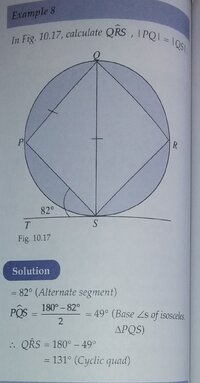
So it is correct! The problem does make a lot sense now.
Dr.Peterson
Elite Member
- Joined
- Nov 12, 2017
- Messages
- 16,604
No, the drawing is clearly inaccurate. The relationships shown are all correct, but surely you see that the angles in the picture are very misleading, especially the apparent right angle at S. It definitely misled Highlander; so it can mislead students easily. That makes it a poorly written problem, even though it can be understood and solved by ignoring some implications of the figure, but not others.No, the previous diagram is correct. I later realized they meant to say the reason was because that was a cyclic quadilateral.
See it here:
View attachment 34949
So it is correct! The problem does make a lot sense now.
Mentioning cyclic quadrilaterals is relevant, but it doesn't change it from a senseless problem (it wasn't) to one that makes sense, or from a poorly stated problem (it was) to one that is well stated.
But I am not seeing any right angle in drawing. Perhaps the author did not mention that any exist. Can you see that the tagent was not drawn perpendicular to the radius? So I am not seeing where the right angle is coming from.but surely you see that the angles in the picture are very misleading, especially the apparent right angle at S.
Dr.Peterson
Elite Member
- Joined
- Nov 12, 2017
- Messages
- 16,604
Do you honestly think that these look at all alike?But I am not seeing any right angle in drawing. Perhaps the author did not mention that any exist. Can you see that the tangent was not drawn perpendicular to the radius? So I am not seeing where the right angle is coming from.
It is natural to think that SQ in the original figure looks approximately perpendicular to ST; and PQ and SQ don't look at all similar in length, and the 82 degree angle looks more like 45. The figure is not "wrong" as figures for problems go, as (almost) everything needed for the problem is indicated explicitly; but as I said, it is not accurate.
Figures in problems don't need to be exact, as mine is; but it is helpful if they don't give false impressions. And on the other side, any facts that are needed for a problem should be stated in words, not left to be assumed from the picture (especially from one that is so obviously wrong). So the authors deviated from good practice in both directions.
If you don't "see" a right angle at QST, that's good; you have learned well to see in a picture only what is explicitly marked. Not everyone has that skill.
If you wish to defend the authors, you may; and if you want to therefore imply that Highlander was really stupid to misread QS as a diameter, go ahead. I just won't join you.
Settled!Do you honestly think that these look at all alike?
It is natural to think that SQ in the original figure looks approximately perpendicular to ST; and PQ and SQ don't look at all similar in length, and the 82 degree angle looks more like 45. The figure is not "wrong" as figures for problems go, as (almost) everything needed for the problem is indicated explicitly; but as I said, it is not accurate.
Figures in problems don't need to be exact, as mine is; but it is helpful if they don't give false impressions. And on the other side, any facts that are needed for a problem should be stated in words, not left to be assumed from the picture (especially from one that is so obviously wrong). So the authors deviated from good practice in both directions.
If you don't "see" a right angle at QST, that's good; you have learned well to see in a picture only what is explicitly marked. Not everyone has that skill.
If you wish to defend the authors, you may; and if you want to therefore imply that Highlander was really stupid to misread QS as a diameter, go ahead. I just won't join you.

